From the Eurasian Steppes to the Roman Circuses: A Review of Early Development of Horse Breeding and Management
Abstract
Simple Summary
Abstract
1. Introduction
2. Horse Domestication and the Beginning of Horse Riding
3. Spreading of Horses in the Ancient World
4. The Influence of Warfare on Breeding Criteria
5. Breeding Objectives
5.1. Overall Conformation
5.2. Height at Withers
5.3. Coat Color
5.4. Racing Performance
- Ancient horsemen were unaware of heredity, and so-called breeding was in fact, just reproduction to obtain animals for further use.
- Racehorses’ evaluation for breeding was based solely on progeny performance. Most valuable individuals of both sexes were kept for breeding and not raced to prevent injuries at the racetrack.
6. Breeding Practices
6.1. Inbreeding
6.2. Genetic Diversity
6.3. Hybridization
7. Stud Management and Horse Husbandry in Classical Antiquity
7.1. Herd Size and Management
7.2. Stock’s Herd Life
7.3. Breeding Season
7.4. Covering Methods and Techniques
7.5. Foal Raising and Weaning
7.6. Feeding
8. Development of the Horse Industry in Classical Antiquity
8.1. Veterinary Medicine
8.2. Training
8.3. Stable Staff
8.4. Competitions
9. Conclusions
Author Contributions
Funding
Institutional Review Board Statement
Informed Consent Statement
Data Availability Statement
Conflicts of Interest
References
- Donaghy, T. Horse Breeds and Breeding in the Greco-Persian World: 1st and 2nd Millennium BC; Cambridge Scholars Publishing: Cambridge, UK, 2014; ISBN 1443863084. [Google Scholar]
- Levine, M.A. Botai and the origins of horse domestication. J. Anthropol. Archaeol. 1999, 18, 29–78. [Google Scholar] [CrossRef]
- Jansen, T.; Forster, P.; Levine, M.A.; Oelke, H.; Hurles, M.; Renfrew, C.; Weber, J.; Olek, K. Mitochondrial DNA and the origins of the domestic horse. Proc. Natl. Acad. Sci. USA 2002, 99, 10905–10910. [Google Scholar] [CrossRef] [PubMed]
- Orlando, L. The Evolutionary and Historical Foundation of the Modern Horse: Lessons from Ancient Genomics. Annu. Rev. Genet. Annu. Rev. 2020, 54, 563–581. [Google Scholar] [CrossRef] [PubMed]
- Robinson, I.H. The human-horse relationship: How much do we know? Equine Vet. J. 1999, 31, 42–45. [Google Scholar] [CrossRef] [PubMed]
- Hausberger, M.; Roche, H.; Henry, S.; Visser, E.K. A review of the human-horse relationship. Appl. Anim. Behav. Sci. 2008, 109, 1–24. [Google Scholar] [CrossRef]
- Thompson, D.W. Historia Animalium. In The Works of Aristotle; Smith, J.A., Ross, W.D., Eds.; Clarendon Press: Oxford, UK, 1910; Volume 4, p. 633. [Google Scholar]
- Columella, L.I.M. On Agriculture; Books 5–9; Forster, E.S., Heffner, E.H., Eds.; Loeb Class.; Harvard University Press: Cambridge, MA, USA, 1989; Volume II, ISBN 0674994485. [Google Scholar]
- Cato, M.P.; Varro, M.T. De Re Rustica; Ash, H.B., Page, T.E., Hooper, W.D., Eds.; Loeb Class.; Harvard University Press: Cambridge, MA, USA, 1967; ISBN 9780674993136. [Google Scholar]
- Donaghy, T. From Aristotle to Pelagonius: Greek and Latin writers on ancient horse breeding. Vet. Hist. 2016, 18, 320–344. [Google Scholar]
- Virgil. The Georgics; Book III–IV; Thomas, R.F., Ed.; Cambridge University Press: Cambridge, UK, 2008; Volume II, ISBN 978-0521346788. [Google Scholar]
- Van Kolfschoten, T. The palaeolithic locality Schöningen (Germany): A review of the mammalian record. Quat. Int. 2014, 326–327, 469–480. [Google Scholar] [CrossRef]
- Fages, A.; Seguin-Orlando, A.; Germonpré, M.; Orlando, L. Horse males became over-represented in archaeological assemblages during the Bronze Age. J. Archaeol. Sci. Rep. 2020, 31, 102364. [Google Scholar] [CrossRef]
- Richardson, C. The Horse Breakers; J. A. Allen & Co. Ltd.: London, UK, 1998; ISBN 0851317227. [Google Scholar]
- Chamberlin, J.E. Horse. How The Horse Has Shaped Civilizations; BlueBridge: Charlottesville, VA, USA, 2006; ISBN 1933346132. [Google Scholar]
- Gaunitz, C.; Fages, A.; Hanghøj, K.; Albrechtsen, A.; Khan, N.; Schubert, M.; Seguin-Orlando, A.; Owens, I.J.; Felkel, S.; Bignon-Lau, O.; et al. Ancient genomes revisit the ancestry of domestic and Przewalski’s horses. Science 2018, 360, 111–114. [Google Scholar] [CrossRef]
- Mileto, S.; Kaiser, E.; Rassamakin, Y.; Evershed, R.P. New insights into the subsistence economy of the Eneolithic Dereivka culture of the Ukrainian North-Pontic region through lipid residues analysis of pottery vessels. J. Archaeol. Sci. Rep. 2017, 13, 67–74. [Google Scholar] [CrossRef]
- Orlando, L. Ancient Genomes Reveal Unexpected Horse Domestication and Management Dynamics. BioEssays 2020, 42. [Google Scholar] [CrossRef]
- Olsen, S.L.; Bradley, B.; Maki, D.; Outram, A.K. Community organization among Copper Age sedentary horse pastoralists of Kazakhstan. In Proceedings of the Beyond the Steppe and the Sown: Proceedings of the 2002 University of Chicago Conference on Eurasian Archaeology (Colloquia Pontica); Peterson, D.L., Popova, M., Smith, A.T., Eds.; Brill Academic Publishers: Chicago, IL, USA, 2006; pp. 89–111. [Google Scholar]
- Olsen, S.L. The exploitation of horses at Botai, Kazakhstan. In Prehistoric Steppe Adaptation and the Horse; Levine, M., Renfrew, C., Boyle, K., Eds.; McDonald Institute: Cambridge, UK, 2003; pp. 83–104. [Google Scholar]
- Outram, A.K.; Stear, N.A.; Bendrey, R.; Olsen, S.L.; Kasparov, A.; Zaibert, V.; Thorpe, N.; Evershed, R.P. The earliest horse harnessing and milking. Science 2009, 323, 1332–1335. [Google Scholar] [CrossRef]
- Anthony, D.W.; Brown, D.R. Eneolithic horse exploitation in the Eurasian steppes: Diet, ritual and riding. Antiquity 2000, 74, 75–86. [Google Scholar] [CrossRef]
- Bökönyi, S. The earliest waves of domestic horses in East Europe. J. Indo-Eur. Stud. 1978, 6, 17–76. [Google Scholar]
- Levine, M.A. Dereivka and the problem of horse domestication. Antiquity 1990, 64, 727–740. [Google Scholar] [CrossRef]
- Bökönyi, S. History of Domestic Mammals in Central and Eastern Europe; Akademiai Kiado: Budapest, Hungary, 1974; ISBN 056908153X. [Google Scholar]
- Lira, J.; Linderholm, A.; Olaria, C.; BrandstrÖm Durling, M.; Gilbert, M.T.P.; Ellegren, H.; Willerslev, E.; Lidén, K.; Arsuaga, J.L.; GötherstrÖm, A. Ancient DNA reveals traces of Iberian Neolithic and Bronze Age lineages in modern Iberian horses. Mol. Ecol. 2010, 19, 64–78. [Google Scholar] [CrossRef]
- Arbuckle, B.S. Animals and inequality in Chalcolithic central Anatolia. J. Anthropol. Archaeol. 2012, 31, 302–313. [Google Scholar] [CrossRef]
- Fages, A.; Hanghøj, K.; Khan, N.; Gaunitz, C.; Seguin-Orlando, A.; Leonardi, M.; McCrory Constantz, C.; Gamba, C.; Al-Rasheid, K.A.S.; Albizuri, S.; et al. Tracking Five Millennia of Horse Management with Extensive Ancient Genome Time Series. Cell 2019, 177, 1419–1435.e31. [Google Scholar] [CrossRef]
- Guimaraes, S.; Arbuckle, B.S.; Peters, J.; Adcock, S.E.; Buitenhuis, H.; Chazin, H.; Manaseryan, N.; Uerpmann, H.P.; Grange, T.; Geigl, E.M. Ancient DNA shows domestic horses were introduced in the southern Caucasus and Anatolia during the Bronze Age. Sci. Adv. 2020, 6. [Google Scholar] [CrossRef]
- Anthony, D.W. The Horse, the Heel, and Language: How Bronze-Age Riders from the Eurasian Steppes Shaped the Modern World; Princeton University Press: Princeton, NJ, USA, 2007; ISBN 9781400831104. [Google Scholar]
- Chechushkov, I.V.; Epimakhov, A.V. Eurasian Steppe Chariots and Social Complexity during the Bronze Age. J. World Prehistory 2018, 31, 435–483. [Google Scholar] [CrossRef]
- Bakker, J.A.; Kruk, J.; Lanting, A.E.; Milisauskas, S. The earliest evidence of wheeled vehicles in Europe and the Near East. Antiquity 1999, 73, 778. [Google Scholar] [CrossRef]
- Kohl, P.L. The Making of Bronze Age Eurasia; Cambridge University Press: Cambridge, UK, 2007; ISBN 978-0521847803. [Google Scholar]
- Koryakova, L.; Epimakhov, A. The Urals and Western Siberia in the Bronze and Iron Ages; Cambridge University Press: Cambridge, UK, 2007; ISBN 9780511618451. [Google Scholar]
- Anthony, D.W.; Telegin, D.Y.; Brown, D.R. The Origin of Horseback Riding. Sci. Am. 1991, 265, 94–101. [Google Scholar] [CrossRef]
- Bendrey, R. New methods for the identification of evidence for bitting on horse remains from archaeological sites. J. Archaeol. Sci. 2007, 34, 1036–1050. [Google Scholar] [CrossRef]
- Drews, R. Early Riders: The Beginnings of Mounted Warfare in Asia and Europe; Routledge: London, UK, 2004; ISBN 978-0415486804. [Google Scholar]
- Weingarten, J. Aegean Seals. An Introduction. Am. J. Archaeol. 2006, 110, 320–322. [Google Scholar]
- Littauer, M.A.; Crouwel, J.H. The Earliest Evidence for Metal Bridle Parts. Oxford J. Archaeol. 2001, 20, 329–338. [Google Scholar] [CrossRef]
- Rossel, S.; Marshall, F.; Peters, J.; Pilgram, T.; Adams, M.D.; O’Connor, D. Domestication of the donkey: Timing, processes, and indicators. Proc. Natl. Acad. Sci. USA 2008, 105, 3715–3720. [Google Scholar] [CrossRef]
- Kimura, R.; Tefera, S. Taming requirements in the domestication process of donkeys: The methods and concepts of the training among the Afar pastoralists in Ethiopia. Pastoralism 2018, 8. [Google Scholar] [CrossRef]
- Chondros, T.G.; Milidonis, K.F.; Rossi, C.; Zrnic, N. The evolution of the double-horse chariots from the bronze age to the Hellenistic times. FME Trans. 2016, 44, 229–236. [Google Scholar] [CrossRef]
- Drews, R. The End of the Bronze Age; Princeton University Press: Princeton, NJ, USA, 1993; ISBN 9780691209975. [Google Scholar]
- Littauer, M.A.; Crouwel, J.H. The origin of the true chariot. Antiquity 1996, 70, 934–939. [Google Scholar] [CrossRef]
- De Barros Damgaard, P.; Martiniano, R.; Kamm, J.; Víctor Moreno-Mayar, J.; Kroonen, G.; Peyrot, M.; Barjamovic, G.; Rasmussen, S.; Zacho, C.; Baimukhanov, N.; et al. The first horse herders and the impact of early Bronze Age steppe expansions into Asia. Science 2018, 360. [Google Scholar] [CrossRef]
- McMiken, D.F. Ancient origins of horsemanship. Equine Vet. J. 1990, 22, 73–78. [Google Scholar] [CrossRef] [PubMed]
- Anthony, D.W. The Sintashta Genesis. The Roles of Climate Change, Warfare, and Long-Distance Trade. In Social Complexity in Prehistoric Eurasia. Monuments, Metals, and Mobility; Hanks, B.K., Linduff, K.M., Eds.; Cambridge University Press: New York, NY, USA, 2009; pp. 47–73. [Google Scholar]
- Littauer, M.A.; Crouwel, J. Wheeled Vehicles and Ridden Animals in the Ancient Near East; Brill: Leiden, The Netherlands, 1987; ISBN 9004059539. [Google Scholar]
- Olsen, S.L. Early Horse Domestication on the Eurasian Steppe. In Documenting Domestication: New Genetic and Archaeological Paradigms; Zeder, M.A., Bradley, D.G., Emshwiller, E., Smith, B.D., Eds.; University of California Press: Berkeley, CA, USA, 2006; pp. 245–269. [Google Scholar]
- Moorey, P.R.S. The emergence of the light, horse-drawn chariot in the Near-East c. 2000–1500 B.C. World Archaeol. 1986, 18, 196–215. [Google Scholar] [CrossRef]
- Latacz, J. Troy and Homer: Towards a Solution of an Old Mystery; Oxford University Press: Oxford, UK, 2004; ISBN 978-0199263080. [Google Scholar]
- Oki, H.; Sasaki, Y.; Willham, R.L. Genetic parameter estimates for racing time by restricted maximum likelihood in the Thoroughbred horse of Japan. J. Anim. Breed. Genet. 1995, 112, 146–150. [Google Scholar] [CrossRef]
- Sobczyńska, M. Environmental factors affecting the speed of Thoroughbred horses competing in Poland. Anim. Sci. Pap. Rep. 2011, 29, 303–312. [Google Scholar]
- Hitchens, P.L.; Leigh Blizzard, C.; Jones, G.; Day, L.M.; Fell, J. The association between jockey experience and race-day falls in flat racing in Australia. Inj. Prev. 2012, 18, 385–391. [Google Scholar] [CrossRef] [PubMed]
- Crouwel, J.H. Chariots and Other Means of Land Transport in Bronze Age Greece; Allard Pierson Museum: Amsterdam, The Netherlands, 1981; pp. 28–38. [Google Scholar]
- Anthony, D.W.; Brown, D.R. The Secondary Products Revolution, Horse-Riding, and Mounted Warfare. J. World Prehistory 2011, 24, 131–160. [Google Scholar] [CrossRef]
- Di Cosmo, N. State formation and periodization in inner Asia. Int. Hist. Rev. 1999, 20, 287–309. [Google Scholar]
- Ewers, J.C. The Horse In Blackfoot Indian Culture with Comparative Material from Other Western Tribes; Smithsonian Institution Bureau of American Ethnology, Ed.; United States Government Printing Office: Washington, DC, USA, 1955; Volume 159, ISBN 1333077653.
- Anderson, J.K. Homeric, British and Cyrenaic Chariots. Am. J. Archaeol. 1965, 69, 349–352. [Google Scholar] [CrossRef]
- Littauer, M.A. The Military Use of the Chariot in the Aegean in the Late Bronze Age. Am. J. Archaeol. 1972, 76, 145. [Google Scholar] [CrossRef]
- Crouwel, J.H. Chariots and Other Wheeled Vehicles in Iron Age Greece; Allard Pierson Museum: Amsterdam, The Netherlands, 1992; ISBN 978-9071211218. [Google Scholar]
- Littauer, M.A.; Crouwel, J.H. Robert Drews and the role of chariotry in bronze age Greece. Oxf. J. Archaeol. 1996, 15, 297–305. [Google Scholar] [CrossRef]
- Kelder, J. Horseback Riding and Cavalry in Mycenaean Greece. Anc. West East 2012, 11, 1–18. [Google Scholar] [CrossRef]
- Gaebel, R.E. Cavalry Operations in the Ancient Greek World; University of Oklahoma Press: Norman, OK, USA, 2002; ISBN 978-0806134444. [Google Scholar]
- Greenhalgh, P.A.L. Early Greek Warfare: Horsemen and Chariots in the Homeric and Archaic Ages; Cambridge University Press: Cambridge, UK, 1973; ISBN 978-0521181280. [Google Scholar]
- Stefaniuk-Szmukier, M.; Ropka-Molik, K.; Piórkowska, K.; Szmatoła, T.; Długosz, B.; Pisarczyk, W.; Bugno-Poniewierska, M. Variation in TBX3 Gene Region in Dun Coat Color Polish Konik Horses. J. Equine Vet. Sci. 2017, 49, 60–62. [Google Scholar] [CrossRef]
- May-Davis, S.; Brown, W.Y.; Shorter, K.; Vermeulen, Z.; Butler, R.; Koekkoek, M. A Novel Non-Invasive Selection Criterion for the Preservation of Primitive Dutch Konik Horses. Animals 2018, 8, 21. [Google Scholar] [CrossRef]
- Stachurska, A.M. Inheritance of primitive markings in horses. J. Anim. Breed. Genet. 1999, 116, 29–38. [Google Scholar] [CrossRef]
- Benirschke, K.; Malouf, N.; Low, R.J.; Heck, H. Chromosome complement: Differences between Equus caballus and Equus przewalskii, Poliakoff. Science 1965, 148, 382–383. [Google Scholar] [CrossRef]
- Wallner, B.; Brem, G.; Müller, M.; Achmann, R. Fixed nucleotide differences on the Y chromosome indicate clear divergence between Equus przewalskii and Equus caballus. Anim. Genet. 2003, 34, 453–456. [Google Scholar] [CrossRef]
- Creel, H.G. The Role of the Horse in Chinese History. Am. Hist. Rev. 1965, 70, 647. [Google Scholar] [CrossRef]
- Azzaroli, A. An Early History of Horsemanship; Brill: Leiden, The Netherlands, 1985; ISBN 9004072330. [Google Scholar]
- Delpeut, L.; Hettema, H. Ancient Arabian horses? Revisiting ancient Egyptian equine imagery. In Proceedings of the Current Research in Egyptology 2019: Proceedings of the Twentieth Annual Symposium, University of Alcalá, 17–21 June 2019; Archaeopress Publishing Ltd.: Gloucestershire, UK, 2021; p. 168. [Google Scholar]
- Wentworth, J. Horses of The World. West. Horseman 1946, 2, 18–19, 50–51, 54–55. [Google Scholar]
- Czarnecki, R. Effect of Polish and foreign purebred Arabian stallions on conformation traits of their progeny participating in shows in the last decade. J. Cent. Eur. Agric. 2014, 15, 115–123. [Google Scholar] [CrossRef][Green Version]
- Kaproń, M.; Czerniak, E.; Łukaszewicz, M.; Danielewicz, A. The breeding value of Wielkopolski horses belonging to particular stallion lineages in the successive volume of the stud book, as evidenced by their body conformation and performance traits. Acta Sci. Pol. Zootech. 2015, 14, 77–90. [Google Scholar]
- Francfort, H.-P.; Lepetz, S. Les chevaux de Berel’ (Altaï)—Chevaux steppiques et chevaux achéménides: Haras et races. Histoire d’équidés 2010, 4, 57–104. [Google Scholar]
- Librado, P.; Gamba, C.; Gaunitz, C.; Der Sarkissian, C.; Pruvost, M.; Albrechtsen, A.; Fages, A.; Khan, N.; Schubert, M.; Jagannathan, V.; et al. Ancient genomic changes associated with domestication of the horse. Science 2017, 356, 442–445. [Google Scholar] [CrossRef] [PubMed]
- Signer-Hasler, H.; Flury, C.; Haase, B.; Burger, D.; Simianer, H.; Leeb, T.; Rieder, S. A genome-wide association study reveals loci influencing height and other conformation traits in horses. PLoS ONE 2012, 7, e37282. [Google Scholar] [CrossRef] [PubMed]
- Willekes, C. Breeding success: The creation of the racehorse in antiquity. Mouseion 2019, 16, 453–469. [Google Scholar] [CrossRef]
- Johnstone, C.J. A Biometric Study of Equids in the Roman World; University of York: York, UK, 2004. [Google Scholar]
- Rieder, S. Molecular tests for coat colours in horses. J. Anim. Breed. Genet. 2009, 126, 415–424. [Google Scholar] [CrossRef]
- Cieslak, M.; Reissmann, M.; Hofreiter, M.; Ludwig, A. Colours of domestication. Biol. Rev. 2011, 86, 885–899. [Google Scholar] [CrossRef]
- Sponenberg, D.P.; Bellone, R. Equine Color Genetics, 4th ed.; Iowa State University Press: Ames, IA, USA, 2017; ISBN 9781119130628. [Google Scholar]
- Ludwig, A.; Pruvost, M.; Reissmann, M.; Benecke, N.; Brockmann, G.A.; Castaños, P.; Cieslak, M.; Lippold, S.; Llorente, L.; Malaspinas, A.S.; et al. Coat color variation at the beginning of Horse domestication. Science 2009, 324, 485. [Google Scholar] [CrossRef]
- Pruvost, M.; Bellone, R.R.; Benecke, N.; Sandoval-Castellanos, E.; Cieslak, M.; Kuznetsova, T.; Morales-Munĩz, A.; O’Connor, T.; Reissmann, M.; Hofreiter, M.; et al. Genotypes of predomestic horses match phenotypes painted in Paleolithic works of cave art. Proc. Natl. Acad. Sci. USA 2011, 108, 18626–18630. [Google Scholar] [CrossRef]
- Kukekova, A.V.; Trut, L.N.; Chase, K.; Shepeleva, D.V.; Vladimirova, A.V.; Kharlamova, A.V.; Oskina, I.N.; Stepika, A.; Klebanov, S.; Erb, H.N.; et al. Measurement of segregating behaviors in experimental silver fox pedigrees. Behav. Genet. 2008, 38, 185–194. [Google Scholar] [CrossRef]
- Trut, L.N. Early canid domestication: The farm-fox experiment: Foxes bred for tamability in a 40-year experiment exhibit remarkable transformations that suggest an interplay between behavioral genetics and development. Am. Sci. 1999, 87, 160–169. [Google Scholar] [CrossRef]
- van Dierendonck, M.; Goodwin, D. Social contact in horses: Implications for human-horse interractions. In The Human-Animal Relationship: Forever and a Day; Jonge, F.H., de Bos, R., van den Gorcum, U., Eds.; Royal Van Gorcum: Aasen, The Netherlands, 2005; pp. 65–81. ISBN 9023240820. [Google Scholar]
- Trut, L.N.; Oskina, I.N.; Kharlamova, A.V. Experimental studies of early canid domestication. In Genetics of the Dog, 2nd ed.; Ruvinsky, A., Sampson, J., Eds.; CABI Pub: Etham, UK, 2012; pp. 12–37. ISBN 9781845939403. [Google Scholar]
- Prasolova, L.A.; Oskina, I.N.; Plyusnina, I.; Trut, L.N. Maternal methyl supplements affect the phenotypic variation of the agouti gene in the offspring of rats with different behavioral types. Russ. J. Genet. 2009, 45, 587–592. [Google Scholar] [CrossRef]
- Albert, F.W.; Carlborg, Ö.; Plyusnina, I.; Besnier, F.; Hedwig, D.; Lautenschläger, S.; Lorenz, D.; McIntosh, J.; Neumann, C.; Richter, H.; et al. Genetic architecture of tameness in a rat model of animal domestication. Genetics 2009, 182, 541–554. [Google Scholar] [CrossRef]
- Jacobs, L.N.; Staiger, E.A.; Albright, J.D.; Brooks, S.A. The MC1R and ASIP coat color loci may impact behavior in the horse. J. Hered. 2016, 107, 214–219. [Google Scholar] [CrossRef]
- Rankins, E.M.; Wickens, C.L. A systematic review of equine personality. Appl. Anim. Behav. Sci. 2020, 231, 105076. [Google Scholar] [CrossRef]
- Schubert, M.; Jónsson, H.; Chang, D.; Der Sarkissian, C.; Ermini, L.; Ginolhac, A.; Albrechtsen, A.; Dupanloup, I.; Foucal, A.; Petersen, B.; et al. Prehistoric genomes reveal the genetic foundation and cost of horse domestication. Proc. Natl. Acad. Sci. USA 2014, 111, E5661–E5669. [Google Scholar] [CrossRef]
- Librado, P.; Der Sarkissian, C.; Ermini, L.; Schubert, M.; Jónsson, H.; Albrechtsen, A.; Fumagalli, M.; Yang, M.A.; Gamba, C.; Seguin-Orlando, A.; et al. Tracking the origins of Yakutian horses and the genetic basis for their fast adaptation to subarctic environments. Proc. Natl. Acad. Sci. USA 2015, 112, E6889–E6897. [Google Scholar] [CrossRef]
- Bell, S.W.; Willekes, C. Horse Racing and Chariot Racing. In The Oxford Handbook of Animals in Classical Thought and Life; Campbell, G.L., Ed.; Oxford University Press: Oxford, UK, 2014; pp. 478–490. [Google Scholar]
- Hyland, A. The Horse in the Ancient World; Praeger: Westport, CT, USA, 2003; ISBN 978-0275981143. [Google Scholar]
- Monard, A.M.; Duncan, P. Consequences of natal dispersal in female horses. Anim. Behav. 1996, 52, 565–579. [Google Scholar] [CrossRef]
- Warmuth, V.; Eriksson, A.; Bower, M.A.; Barker, G.; Barrett, E.; Hanks, B.K.; Li, S.; Lomitashvili, D.; Ochir-Goryaeva, M.; Sizonovg, G.V.; et al. Reconstructing the origin and spread of horse domestication in the Eurasian steppe. Proc. Natl. Acad. Sci. USA 2012, 109, 8202–8206. [Google Scholar] [CrossRef]
- Warmuth, V.; Manica, A.; Eriksson, A.; Barker, G.; Bower, M. Autosomal genetic diversity in non-breed horses from eastern Eurasia provides insights into historical population movements. Anim. Genet. 2013, 44, 53–61. [Google Scholar] [CrossRef]
- Lippold, S.; Matzke, N.J.; Reissmann, M.; Hofreiter, M. Whole mitochondrial genome sequencing of domestic horses reveals incorporation of extensive wild horse diversity during domestication. BMC Evol. Biol. 2011, 11, 328. [Google Scholar] [CrossRef]
- Achilli, A.; Olivieri, A.; Soares, P.; Lancioni, H.; Kashani, B.H.; Perego, U.A.; Nergadze, S.G.; Carossa, V.; Santagostino, M.; Capomaccio, S.; et al. Mitochondrial genomes from modern horses reveal the major haplogroups that underwent domestication. Proc. Natl. Acad. Sci. USA 2012, 109, 2449–2454. [Google Scholar] [CrossRef]
- Lindgren, G.; Backström, N.; Swinburne, J.; Hellborg, L.; Einarsson, A.; Sandberg, K.; Cothran, E.G.; Vilà, C.; Binns, M.M.; Ellegren, H. Limited number of patrilines in horse domestication. Nat. Genet. 2004, 36, 335–336. [Google Scholar] [CrossRef]
- Ling, Y.; Ma, Y.; Guan, W.; Cheng, Y.; Wang, Y.; Han, J.; Jin, D.; Mang, L.; Mahmut, H. Identification of y chromosome genetic variations in Chinese Indigenous horse breeds. J. Hered. 2010, 101, 639–643. [Google Scholar] [CrossRef]
- Lippold, S.; Knapp, M.; Kuznetsova, T.; Leonard, J.A.; Benecke, N.; Ludwig, A.; Rasmussen, M.; Cooper, A.; Weinstock, J.; Willerslev, E.; et al. Discovery of lost diversity of paternal horse lineages using ancient DNA. Nat. Commun. 2011, 2. [Google Scholar] [CrossRef]
- Wutke, S.; Sandoval-Castellanos, E.; Benecke, N.; Döhle, H.J.; Friederich, S.; Gonzalez, J.; Hofreiter, M.; Lõugas, L.; Magnell, O.; Malaspinas, A.S.; et al. Decline of genetic diversity in ancient domestic stallions in Europe. Sci. Adv. 2018, 4. [Google Scholar] [CrossRef]
- Levine, M.A. Investigating the origins of horse domestication. Equine Vet. J. Suppl. 1999, 28, 6–14. [Google Scholar] [CrossRef]
- McDowell, K.J.; Powell, D.G.; Baker, C.B. Effect of book size and age of mare and stallion on foaling rates in thoroughbred horses. J. Equine Vet. Sci. 1992, 12, 364–367. [Google Scholar] [CrossRef]
- Nagy, P.; Guillaume, D.; Daels, P. Seasonality in mares. Anim. Reprod. Sci. 2000, 60, 245–262. [Google Scholar] [CrossRef]
- Mahboubi, M.; Mohammad Taghizadeh Kashani, L.; Mahboubi, M. Squill (Drimia maritima L.) and its novel biological activity. Orient. Pharm. Exp. Med. 2019, 19, 227–234. [Google Scholar] [CrossRef]
- Waran, N.K.; Clarke, N.; Farnworth, M. The effects of weaning on the domestic horse (Equus caballus). Appl. Anim. Behav. Sci. 2008, 110, 42–57. [Google Scholar] [CrossRef]
- Rodgers, R. Cattle, Horses and Other Livestock: Textual Notes on Columella, Books 6 and 7. Riv. Cult. Class. Medioev. 2009, LI, 1000–1041. [Google Scholar] [CrossRef]
- Raulwing, P. The Kikkuli Text. Hittite Training Instructions for Chariot Horses in the Second Half of the 2nd Millennium BC and Their Interdisciplinary Context. Available online: http://www.lrgaf.org/Peter_Raulwing_The_Kikkuli_Text_MasterFile_Dec_2009.pdf (accessed on 19 April 2021).
- Amemiya, T. Economy and Economics of Ancient Greece; Routledge: Oxford, UK, 2007; ISBN 9781135991715. [Google Scholar]
- Herz, P. Finances and Costs of the Roman Army. In A Companion to the Roman Army; Erdkamp, P., Ed.; Blackwell Publishing Inc.: Oxford, UK, 2007; p. 306. ISBN 9781405121538. [Google Scholar]
- Heesch, J. Van Some Aspects of Wage Payments and Coinage in Ancient Rome, First to Third Centuries AD. In Wages and Currency: Global and Historical Comparisons; Lucassen, J., Ed.; Peter Lang: Berlin, Germany, 2007; pp. 77–96. [Google Scholar]
- Cioffi, R.L. Travel in the Roman World; Oxford University Press: Oxford, UK, 2016; ISBN 9780199935390. [Google Scholar]
- Golden, M. Equestrian Competition in Ancient Greece: Difference, Dissent, Democracy. Phoenix 1997, 51, 327. [Google Scholar] [CrossRef]
- Fischer, K.D. Ancient veterinary medicine. A survey of Greek and Latin sources and some recent scholarship. Medizinhist. J. 1988, 23, 191–209. [Google Scholar] [PubMed]
- Doyen-Higuet, A.-M. The “Hippiatrica” and Byzantine Veterinary Medicine. Dumbart. Oaks Pap. 1984, 38, 111. [Google Scholar] [CrossRef]
- Odder, E.; Hoppe, K. Corpus Hippiatricorum Graecorum. I. Hippiatrica Berolinensia; Teubner, B.G., Ed.; Teubneri: Leipzig, Germany, 1924; pp. 22–38. [Google Scholar]
- Odder, K. Corpus Hippiatricorum Graecorum. II. Hippiatrica Parisina, Cantabrigiensia, Londinensia, Lugdunensia; Teubner: Leipzig, Germany, 1927; pp. 57–59. [Google Scholar]
- Nyland, A. The Kikkuli Method of Horse Training, 2nd ed.; Smith and Stirling: New York, NY, USA, 2008; ISBN 0980443075. [Google Scholar]
- Nicholson, N.J. Aristocracy and Athletics in Archaic and Classical Greece; Cambridge University Press: New York, NY, USA, 2005; ISBN 9780521845229. [Google Scholar]
- Potter, D.S. Entertainers in the Roman Empire. In Life, Death, and Entertainment in the Roman Empire; Potter, D.S., Mattingly, D.J., Eds.; University of Michigan Press: Ann Arbor, MI, USA, 1999; pp. 280–350. ISBN 0472034286. [Google Scholar]
- Hemingway, S.A. The Horse and Jockey from Artemision. A Bronze Equestrian Monument of the Hellenistic Period.; University of California Press: Berkeley, CA, USA, 2004; ISBN 0520233085. [Google Scholar]
- McBane, S.; McCarthy, G. The Competition Horse: Breeding, Production and Management; Blackwell Publishing Ltd.: Oxford, UK, 1991; ISBN 0876058314. [Google Scholar]
- Humphrey, J.H. Roman Circuses: Arenas for Chariot Racing; University of California Press: Berkeley, CA, USA, 1986; ISBN 0520049217. [Google Scholar]
- Bell, S.W. Horse Racing in Imperial Rome: Athletic Competition, Equine Performance, and Urban Spectacle. Int. J. Hist. Sport 2020, 37, 1–50. [Google Scholar] [CrossRef]
- Bell, S. Roman Chariot Racing: Charioteers, Factions, Spectators. In A Companion to Sport and Spectacle in Greek and Roman Antiquity; Blackwell Publishing Inc.: Oxford, UK, 2013; pp. 492–504. [Google Scholar]
- Lim, R. Inventing Secular Space in the Late Antique City: Reading the Circus Maximus. In Rom in der Spätantike: Historiche Erinnerung im Städtischen Raum; Behrwald, R., Witschel, C., Eds.; Franz Steiner: Stuttgart, Germany, 2012; pp. 61–81. [Google Scholar]
- Larson, J. The Emperor, the Church and Chariot Races. The Imperial Struggles with Christianity and Entertainment in Late Antique Constantinople; The University of Edinburgh: Edinburgh, UK, 2012. [Google Scholar]
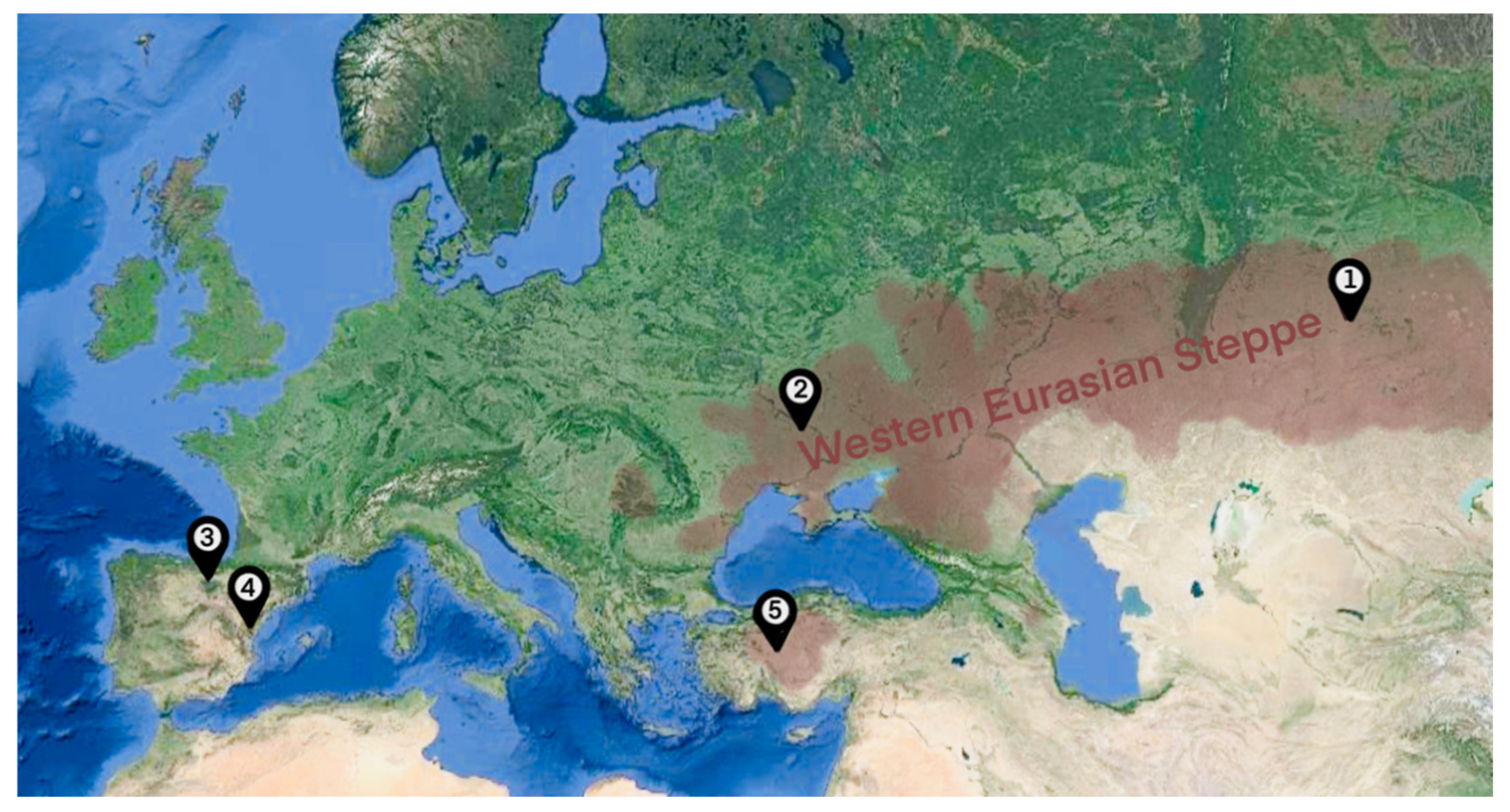
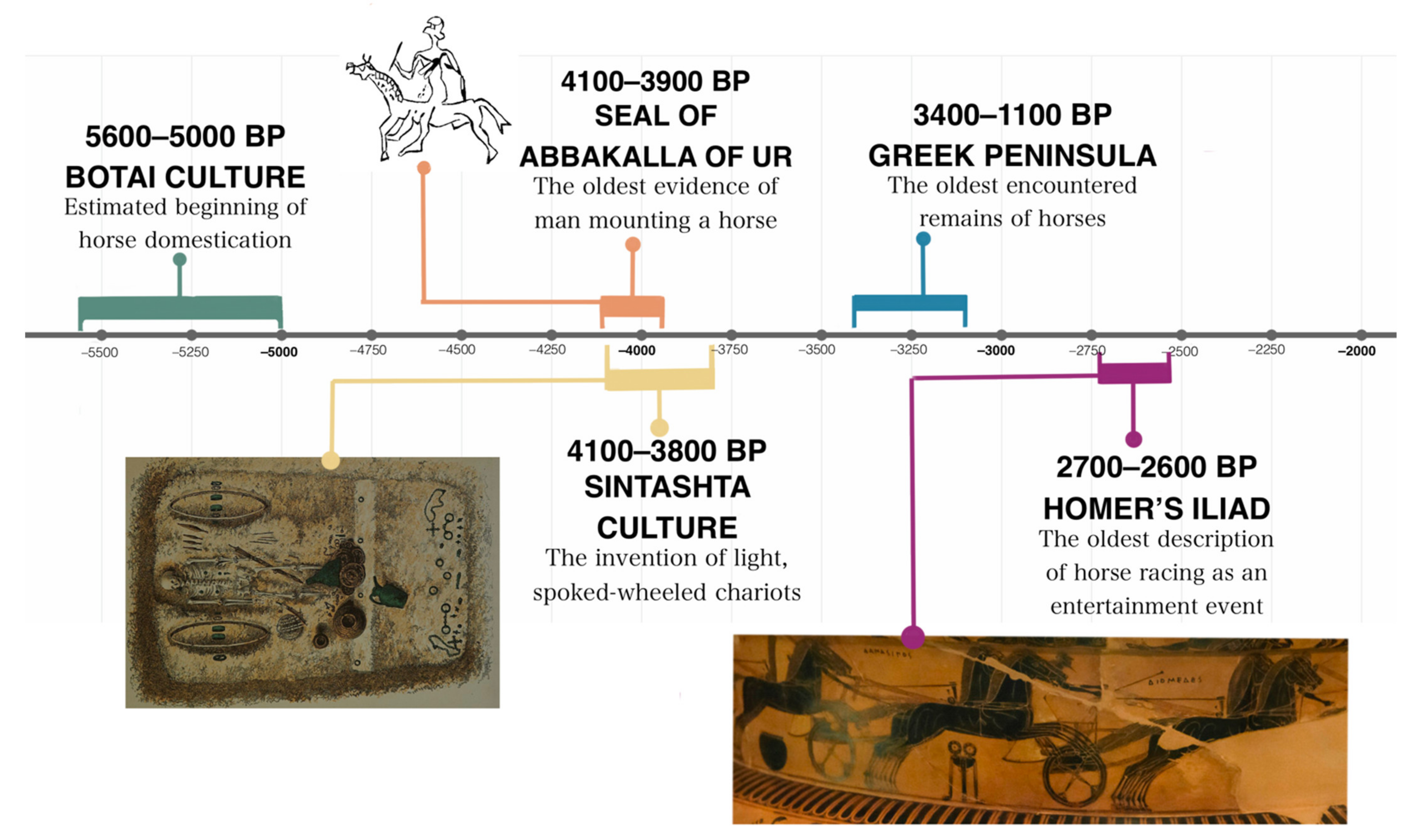
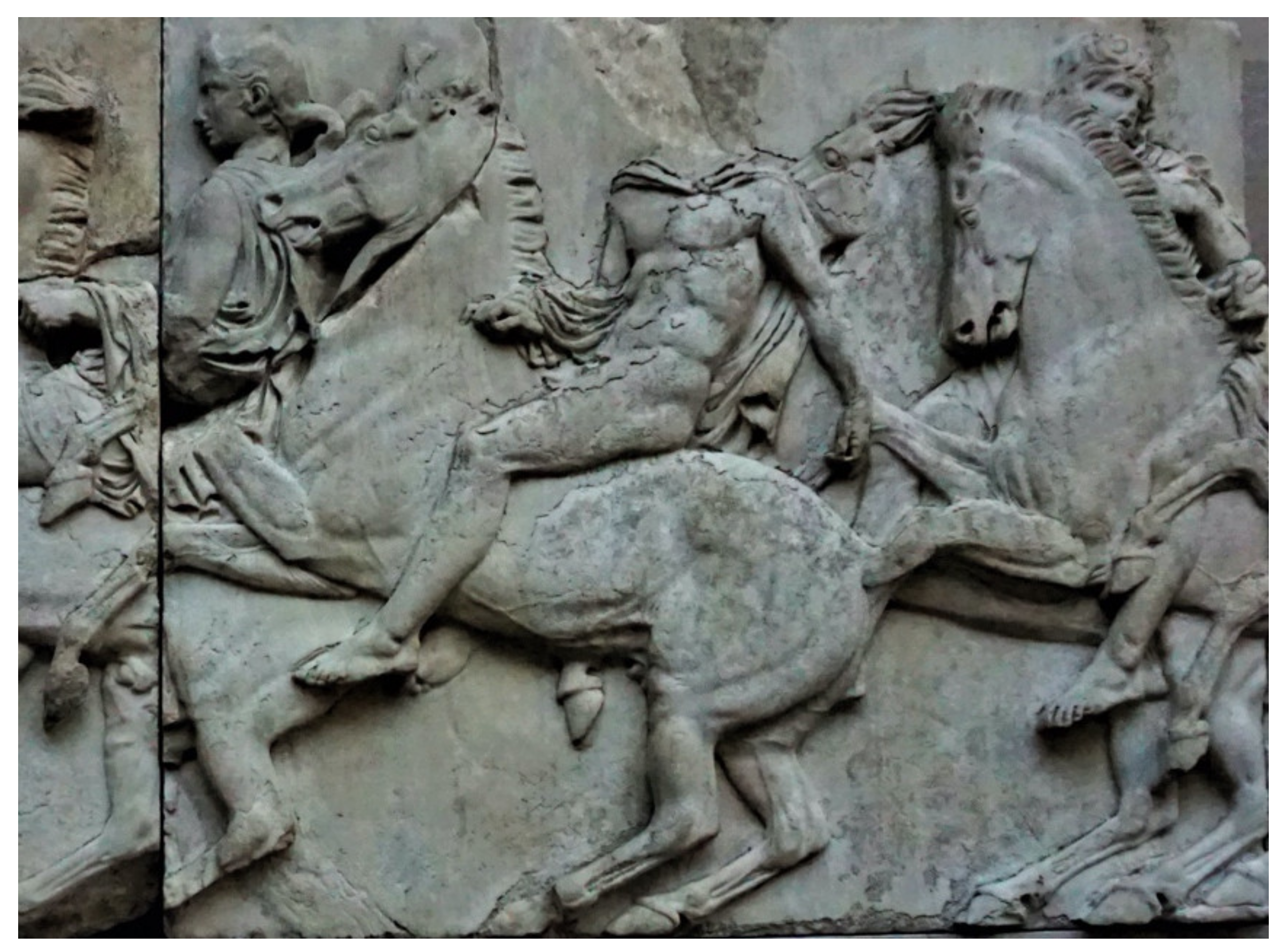
| Phenotype | Locus | Genotype | First Observed | |
|---|---|---|---|---|
| Bay |  | ASIP | AA/- EE/- | Pleistocene [85] |
| Black | 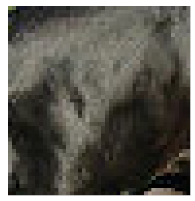 | ASIP | Aa/Aa EE/- | Copper Age [85] |
| Chestnut | 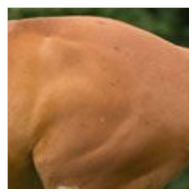 | MC1R | Ee/Ee | 4300 BC [87] |
| Bay leopard | 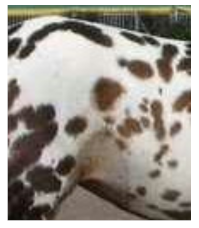 | ASIP TRPM1 | AA/- EE/- LP/- | Pleistocene [83] |
| Chestnut leopard |  | MC1R TRPM1 | Ee/Ee LP/- | 2700 years ago [78] |
Publisher’s Note: MDPI stays neutral with regard to jurisdictional claims in published maps and institutional affiliations. |
© 2021 by the authors. Licensee MDPI, Basel, Switzerland. This article is an open access article distributed under the terms and conditions of the Creative Commons Attribution (CC BY) license (https://creativecommons.org/licenses/by/4.0/).
Share and Cite
Klecel, W.; Martyniuk, E. From the Eurasian Steppes to the Roman Circuses: A Review of Early Development of Horse Breeding and Management. Animals 2021, 11, 1859. https://doi.org/10.3390/ani11071859
Klecel W, Martyniuk E. From the Eurasian Steppes to the Roman Circuses: A Review of Early Development of Horse Breeding and Management. Animals. 2021; 11(7):1859. https://doi.org/10.3390/ani11071859
Chicago/Turabian StyleKlecel, Weronika, and Elżbieta Martyniuk. 2021. "From the Eurasian Steppes to the Roman Circuses: A Review of Early Development of Horse Breeding and Management" Animals 11, no. 7: 1859. https://doi.org/10.3390/ani11071859
APA StyleKlecel, W., & Martyniuk, E. (2021). From the Eurasian Steppes to the Roman Circuses: A Review of Early Development of Horse Breeding and Management. Animals, 11(7), 1859. https://doi.org/10.3390/ani11071859






